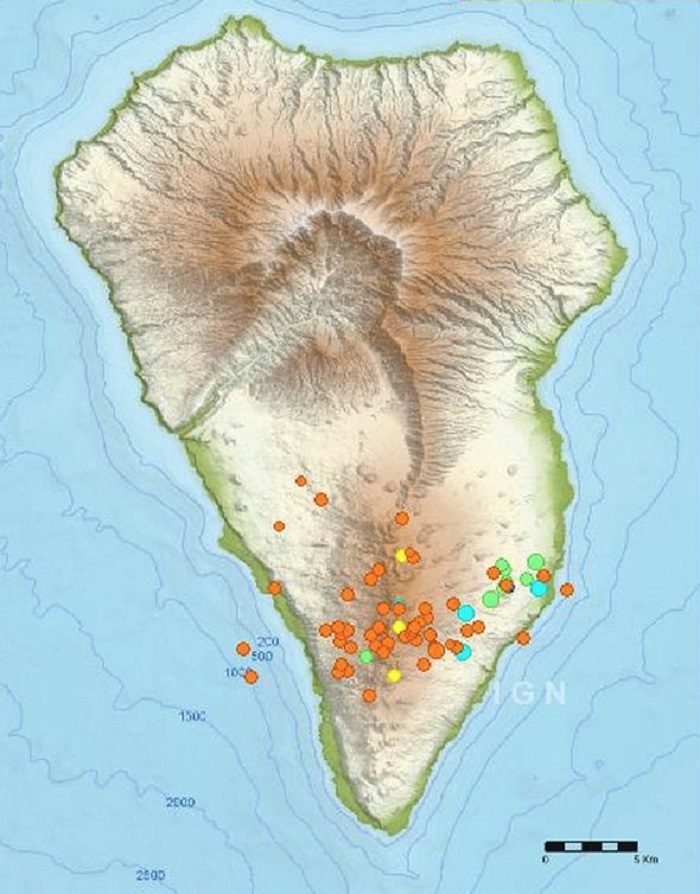Unveiling The Impact Of Earthquake In La Palma Canary Islands
Earthquake in La Palma Canary Islands has become a significant global concern, capturing the attention of scientists, environmentalists, and communities worldwide. The seismic activity occurring in this volcanic hotspot has not only reshaped the landscape but also brought attention to the vulnerabilities of island ecosystems. Understanding the causes, effects, and mitigation strategies surrounding these earthquakes is crucial for both locals and international stakeholders.
La Palma, one of the Canary Islands, is no stranger to seismic activity due to its volcanic nature. However, recent earthquakes have reached magnitudes that demand closer examination. These events have highlighted the need for preparedness and resilience in the face of natural disasters, especially in regions with high tourism and population density.
By delving into the specifics of earthquake occurrences in La Palma, this article aims to provide comprehensive insights into the geological, environmental, and societal impacts. Additionally, we will explore potential strategies to mitigate risks and enhance community safety. Let's embark on this journey to understand the seismic activity in one of the world's most fascinating volcanic islands.
Read also:Aravind Srinivas Education A Comprehensive Guide To His Academic Journey And Achievements
Table of Contents:
- Biography of La Palma
- Geological Overview
- Recent Earthquakes
- Causes of Earthquakes
- Effects on the Environment
- Community Impact
- Mitigation Strategies
- Future Predictions
- Impact on Tourism
- Conclusion
Biography of La Palma
La Palma, the northwesternmost island of the Canary Islands, is a jewel in the Atlantic Ocean. Known for its stunning landscapes and unique biodiversity, La Palma is often referred to as "Isla Bonita" or the beautiful island. However, beneath its picturesque surface lies a volatile geological history that shapes its present and future.
Data and Facts
Below is a summary of key data about La Palma:
| Category | Information |
|---|---|
| Location | Canary Islands, Spain |
| Area | 708 km² |
| Population | Approximately 84,000 |
| Highest Point | Roque de los Muchachos (2,426 meters) |
| Volcanic Activity | Active volcanic island |
Geological Overview
The Canary Islands, including La Palma, are part of a volcanic archipelago formed by hotspot activity. The geological history of La Palma is characterized by intense volcanic activity, which has created its rugged terrain and unique landscapes.
Volcanic Formation
La Palma's volcanic activity dates back millions of years. The island's most famous feature, the Cumbre Vieja volcanic ridge, is responsible for much of its recent seismic activity. This ridge is a testament to the ongoing geological processes that shape the island.
Recent Earthquakes
In recent years, La Palma has experienced a series of earthquakes, with the most notable event occurring in 2021. This earthquake sequence, part of a larger volcanic eruption, had a profound impact on the island's population and environment.
Read also:Unlocking The Mysteries Of The 11 22 Angel Number A Comprehensive Guide
- September 2021: A 5.1 magnitude earthquake triggered a volcanic eruption on La Palma.
- October 2021: Continued seismic activity led to significant lava flows and landmass changes.
Causes of Earthquakes
Earthquakes in La Palma are primarily caused by tectonic and volcanic activity. The island sits on the African Plate, where magma rises through fractures in the Earth's crust, causing seismic events.
Volcanic Contributions
The movement of magma beneath the surface is a key factor in earthquake occurrences. As magma pushes upward, it creates pressure that can lead to fractures and subsequent seismic activity.
Effects on the Environment
The environmental impact of earthquakes in La Palma is profound. From landmass changes to ecological disruptions, these seismic events reshape the island's natural landscape.
- Landmass Expansion: Lava flows have added significant landmass to the island.
- Ecosystem Disruption: Native flora and fauna face challenges adapting to altered habitats.
Community Impact
The people of La Palma have faced significant challenges due to seismic activity. From displacement to economic hardships, the community has shown remarkable resilience in the face of adversity.
Displacement
Thousands of residents have been displaced due to volcanic eruptions and subsequent earthquakes. The local government and international organizations have worked tirelessly to provide support and resources to those affected.
Mitigation Strategies
Efforts to mitigate the impact of earthquakes in La Palma involve a combination of technological advancements and community preparedness. Early warning systems and disaster response plans are crucial components of these strategies.
Technological Solutions
Seismologists use advanced monitoring equipment to track volcanic activity and predict potential earthquakes. These systems provide valuable data that can help protect lives and property.
Future Predictions
While predicting earthquakes with precision remains challenging, ongoing research and monitoring offer insights into potential future events. Scientists continue to study the geological processes underlying La Palma's seismic activity.
Scientific Studies
Research institutions worldwide collaborate to understand the complexities of La Palma's geological dynamics. Studies focus on improving prediction models and enhancing disaster preparedness.
Impact on Tourism
La Palma's tourism industry has been significantly affected by recent earthquakes. However, the island's unique geological features and recovery efforts present opportunities for sustainable tourism development.
Sustainable Tourism
Efforts are underway to promote eco-friendly tourism that highlights La Palma's natural beauty while supporting local communities. This approach aims to balance economic growth with environmental preservation.
Conclusion
In conclusion, the earthquake activity in La Palma Canary Islands underscores the importance of understanding and addressing the challenges posed by natural disasters. From geological processes to community resilience, the lessons learned from these events are invaluable.
We encourage readers to share their thoughts and experiences in the comments section below. Additionally, exploring other articles on our site can provide further insights into global geological phenomena. Together, we can foster a greater awareness and appreciation for the dynamic forces shaping our planet.
References:
- Instituto Geográfico Nacional (IGN) - Spain
- European-Mediterranean Seismological Centre (EMSC)
- United States Geological Survey (USGS)


